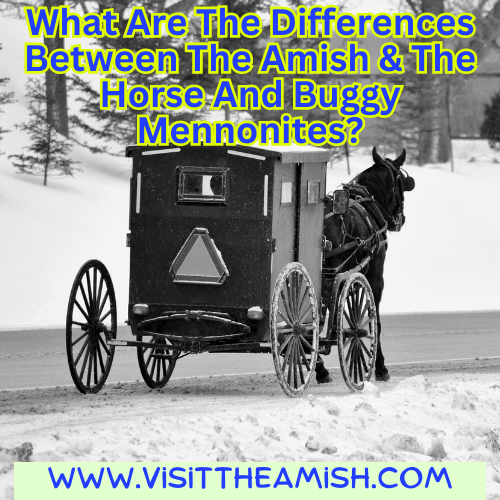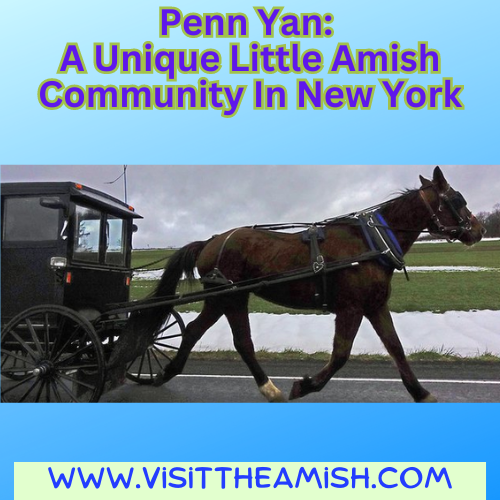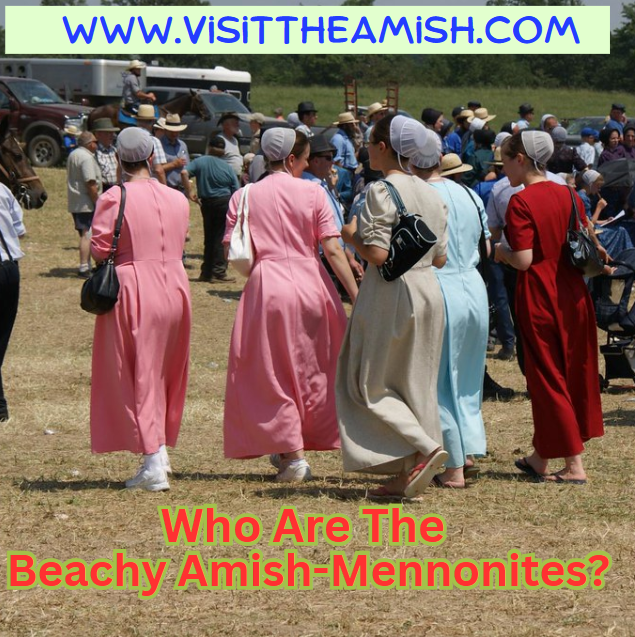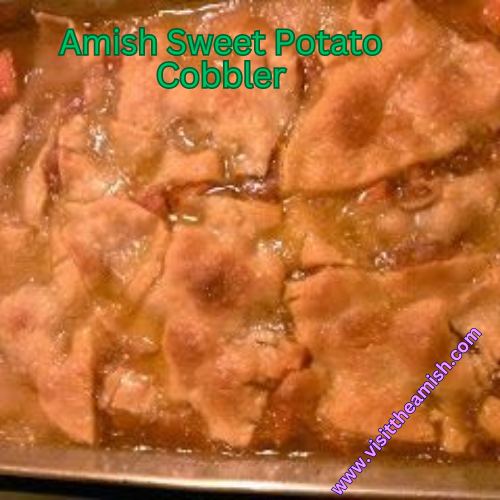What Are The Difference Between The Amish & The Horse And Buggy Mennonites?
Name three differences between the Amish and the Mennonites. Well, that’s a very hard question to answer. Since there are hundreds of different Amish communities and Mennonite communities across America. There are many different forms of Amish and many different beliefs among the Mennonites and customs. And so I will try to give some insight into the difference between the Arthur Illinois Amish and the horse and buggy Mennonites that live in the Pen Yan New York area.
It’s the Finger Lakes area of New York. It’s a very beautiful spot. And first we’ll go over some of the customs and things at the Amish in Art Arthur, Illinois. It’s located in central Illinois.
They have fairly large Amish community here. And first thing you notice is that the Amish men have beards and they wear plain colored clothes. They usually wear suspenders and homemade pants, and then they wear large black felt hats. They, of course, drive horse and buggy, and they also farm with horses, those that farm.
The women wear plain long dresses with capes and large white coverings with strings. The young girls also wear coverings in their homes. They have no electric or phones in their homes. Some businesses do have telephones for their businesses, and if they want to go out of state or any distance, they will hire a driver. They also, they own cabinet shops, bulk food stores, hardware, and many other types of businesses.
They have their churches in their homes, but they do have their own school houses, and they speak Pennsylvania Dutch, and English.
To compare that with the horse and buggy Mennonites in the Penn Yan New York area. The men do not wear beards. They do wear suspenders and they do wear jeans and pants that are bought. Then they either wear a tan straw hat or a black derby type of hat. And the ladies all wear very modestly dressed, but they have a pattern in their material. They’re not plain material.
They wear similar coverings and most of them cover the ear. Most of the younger girls do not wear coverings. But lot of ’em, have their hair in two pigtails and we’re also very modestly dressed.
Same as Illinois, they drive horse and buggy, but they are allowed to farm with steel wheel tractors. Any piece of equipment that is self propelled has to be on steel wheels. The reason for that is so they are not tempted to drive them to town. You cannot have steel wheels on the highway.
They’re also a little more modern as far as their homes. They have electricity in their homes and telephones, and they also hire drivers to go out of state or any long trips.
They’re very industrious and they have many dairy farms. They grow grapes and own a lot of the businesses in the area.
Unlike the Illinois Amish, they have their own church houses, but they also they have their own school houses, and then they also speak Pennsylvania Dutch, and English.
The problem with this question is that, you know, when you say Mennonite, it can be many different things. If you say Amish, you have a pretty clear picture of what you mean. You mean someone plain clothes, a beard or a prayer covering on their head using a horse and buggy using very low or restricted levels of technology.
When you say Mennonite, now that can mean a variety of types of people. You can be anything from a very modern person who uses computer, the internet, cars, and would be indistinguishable visually from, most other Americans. Mennonite can also be someone who also uses a horse in buggy as their primary transportation. That also wears plain clothing, that also speaks Pennsylvania German and that also restricts the use of technology. As you know, a lot of things in common with the Amish.
There’s a lot of range in the churches that use the word Mennonite to describe themselves. So the Amish and Mennonites a couple other groups, the Hutterites, they all share a similar history. They come from a group known as the Anabaptists. Both come from that background in their history.
There was a division, and you had a certain group of followers that followed the leader of Jacob Amman eventually became known as the Amish. They were kind of the more plain and more traditional groups there.
Over time, you’ve had, even within the Amish groups, some that have become more modern and progressive, some churches that have eventually become car driving churches. In contrast to that, you have the Old Order pathway.
When we talk about the Amish today, we generally talk about the Old Order Amish. So the further you get away in those terms, the fewer similarities of Mennonites would have with Old Order Amish.
So the groups that are most similar to the Amish within the Mennonites would be the Old Order Mennonites. And also you could include the Old Colony Mennonites.
The Old Order of Mennonites are significantly smaller group than the Amish, but you’ll find them living side by side just as neighbors with the Amish in certain communities, one would be Lancaster County. There’s a very large old order of Mennonite community there.
You’ll see the Amish and Mennonite Old Order Mennonites living side by side in some places. They also wear plain clothing, though it’s a different style than the Amish. The women wear head coverings, prayer coverings. They use the horse and buggy drive similar buggies to the Amish. Older Mennonite buggies will be a different style. In Lancaster County, you can tell it’s an Amish buggy. By its color, it’s a gray color.
And then the Mennonite buggies there would be black, kind of a little bit different design. They also use restricted levels of technology. The older Mennonites also speak Pennsylvania German as well. So the Amish mission and Mennonites have that in common.
The Old Order Mennonites also cooperate with the Amish in certain ways. They’re culturally close to one another. So you may have things like joint auctions. Certain school houses in Lancaster County are essentially joint Amish and Mennonite schools. So you’ll have children that are Amish and then also plain Mennonites attending those schools.
There are also some conservative Mennonites like Black Bumper Mennonites. And some of those children may also attend those schools. You even have some shared cultural aspects in forms of recreation specifically there as a game called Corner Ball.
That’s a game that I had a chance to witness on one occasion. And it’s basically kind of like a game of dodge ball where you have two teams and they try to hit one another with kind of like a hard ball. I hear the ball can hurt pretty pretty badly if you get hit. And it was Amish teams versus Mennonite teams. And there was, you know, quite a few spectators there.
The Old Order Mennonite men do not grow facial hair, and the Amish men do grow the beard, and they see there’s a biblical basis for that. Another one would be the place of worship.

Now, the Old Order Mennonites will worship in a meeting house. A specially built structure made for worship. Most Amish will worship in the home. It could be in the basement of the home. They have their church gathering there, or in a workshop or another building, even the barn.
Another difference there would be the church structure. The Amish church district, which typically is made up of about 25 to 35 families, somewhere around 150 people total. Each district will have typically its own bishop ministers and a deacon.
Those are some of the differences there. But they tend to be culturally quite alike. So, you know, you’ll see the Amish and the Mennonite cooperating on different things, and they’re gonna be able to relate to each other on the same level.
They have a shared history. They have shared faith essentially. Now, the Old Colony Mennonites are a group that are primarily found in Mexico. They’re found in Belize. Some are located in Canada. There are even a few in the United States, some in other Latin American countries, but the bulk of them would be in Mexico.
This is a group which also uses highly restricted technology. You know, they have differences in their style of plain clothing. They don’t wear beards either. Some of the Old Colony Mennonites do permit and use automobiles, although some do use horse drawn transport. They also speak a different dialect of German.
They often live in significant poverty as well. And there’s been an interesting project where Amish from states like Ohio, Pennsylvania, other places have been going down to Mexico to help teach in Old Colony Mennonite schools. There been a long tradition of Amish doing that now for over two decades.
Old Order Mennonites, Old Colony Mennonite, these are two groups that have similarities with the Amish culturally, and also I would say probably mentaly as well.
When you ask the question, “what’s the difference between the Amish and the Mennonites?” I would say, “Well, “what group of Mennonites are you talking about? Right?”
The plainer Mennonites, are more similar to the Amish. Even in the very ways they live. But even some of the more conservative Mennonites that are car driving would feel like an affinity or like closeness to one another kind of a cultural similarity. Even though one would drive a car, they may still dress in plainer clothing and have plainer ways.
The range within Mennonites is even greater in terms of diversity. You have all the way from horse and buggy driving Mennonites to modern car driving professional people. You have university professors that are Mennonites. You have doctors that are Mennonites. That’s another difference, the more progressive Mennonites will have a higher level of education. They permit a higher level of education, which the Amish don’t. They stop at in eighth grade.
I hope that answers that question.








